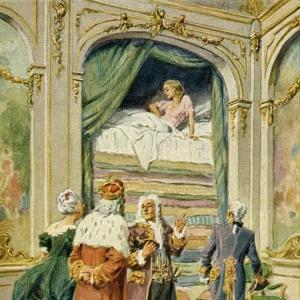Reading time: 12 min
From my father I received the best inheritance, namely a „good temper.“ – „And who was my father?“ That has nothing to do with the good temper; but I will say he was lively, good-looking round, and fat. He was both in appearance and character a complete contradiction to his profession. „And pray what was his profession and his standing in respectable society?“ Well, perhaps, if in the beginning of a book these were written and printed, many, when they read it, would lay the book down and say, „It seems to me a very miserable title, I don’t like things of this sort.“ And yet my father was not a skin-dresser nor an executioner. On the contrary, his employment placed him at the head of the grandest people of the town, and it was his place by right. He had to precede the bishop, and even the princes of the blood. He always went first,– he was a hearse driver! There, now, the truth is out. And I will own, that when people saw my father perched up in front of the omnibus of death, dressed in his long, wide, black cloak, and his black-edged, three-cornered hat on his head, and then glanced at his round, jocund face, round as the sun, they could not think much of sorrow or the grave. That face said, „It is nothing, it will all end better than people think.“ So I have inherited from him, not only my good temper, but a habit of going often to the churchyard, which is good, when done in a proper humor; and then also I take in the Intelligencer, just as he used to do.
I am not very young, I have neither wife nor children, nor a library, but, as I said, I read the Intelligencer, which is enough for me. It is to me a delightful paper, and so it was to my father. It is of great use, for it contains all that a man requires to know. The names of the preachers at the church, and the new books which are published; where houses, servants, clothes, and provisions may be obtained. And then what a number of subscriptions to charities, and what innocent verses! Persons seeking interviews and engagements, all so plainly and naturally stated. Certainly, a man who takes in the Intelligencer may live merrily and be buried contentedly, and by the end of his life will have such a capital stock of paper that he can lie on a soft bed of it, unless he prefers wood shavings for his resting-place. The newspaper and the churchyard were always exciting objects to me. My walks to the latter were like bathing-places to my good humor. Every one can read the newspaper for himself, but come with me to the churchyard while the sun shines and the trees are green, and let us wander among the graves. Each of them is like a closed book, with the back uppermost, on which we can read the title of what the book contains, but nothing more. I had a great deal of information from my father, and I have noticed a great deal myself. I keep it in my diary, in which I write for my own use and pleasure a history of all who lie here, and a few more beside.
Now we are in the churchyard. Here, behind the white iron railings, once a rose-tree grew. It is gone now, but a little bit of evergreen, from a neighboring grave, stretches out its green tendrils, and makes some appearance. There rests a very unhappy man, and yet while he lived he might be said to occupy a very good position. He had enough to live upon, and something to spare; but owing to his refined tastes the least thing in the world annoyed him. If he went to a theatre of an evening, instead of enjoying himself he would be quite annoyed if the machinist had put too strong a light into one side of the moon, or if the representations of the sky hung over the scenes when they ought to have hung behind them; or if a palm-tree was introduced into a scene representing the Zoological Gardens of Berlin, or a cactus in a view of Tyrol, or a beech-tree in the north of Norway. As if these things were of any consequence! Why did he not leave them alone? Who would trouble themselves about such trifles? especially at a comedy, where every one is expected to be amused. Then sometimes the public applauded too much, or too little, to please him. „They are like wet wood,“ he would say, looking round to see what sort of people were present, „this evening; nothing fires them.“ Then he would vex and fret himself because they did not laugh at the right time, or because they laughed in the wrong places; and so he fretted and worried himself till at last the unhappy man fretted himself into the grave.
Here rests a happy man, that is to say, a man of high birth and position, which was very lucky for him, otherwise he would have been scarcely worth notice. It is beautiful to observe how wisely nature orders these things. He walked about in a coat embroidered all over, and in the drawing-rooms of society looked just like one of those rich pearl-embroidered bell-pulls, which are only made for show; and behind them always hangs a good thick cord for use. This man also had a stout, useful substitute behind him, who did duty for him, and performed all his dirty work. And there are still, even now, these serviceable cords behind other embroidered bell-ropes. It is all so wisely arranged, that a man may well be in a good humor.
Here rests,– ah, it makes one feel mournful to think of him!– but here rests a man who, during sixty-seven years, was never remembered to have said a good thing. He lived only in the hope of having a good idea. At last he felt convinced, in his own mind, that he really had one, and was so delighted that he positively died of joy at the thought of having at last caught an idea. Nobody got anything by it; indeed, no one even heard what the good thing was. Now I can imagine that this same idea may prevent him from resting quietly in his grave. For suppose that to produce a good effect, it is necessary to bring out his new idea at breakfast, and that he can only make his appearance on earth at midnight, as ghosts are believed generally to do; why then this good idea would not suit the hour, and the man would have to carry it down again with him into the grave– that must be a troubled grave.
The woman who lies here was so remarkably stingy, that during her life she would get up in the night and mew, that her neighbors might think she kept a cat. What a miser she was!
Here rests a young lady, of a good family, who would always make her voice heard in society, and when she sang „Mi manca la voce,“ it was the only true thing she ever said in her life.
Here lies a maiden of another description. She was engaged to be married,– but, her story is one of every-day life. We will leave her to rest in the grave.
Here rests a widow, who, with music in her tongue, carried gall in her heart. She used to go round among the families near, and search out their faults, upon which she preyed with all the envy and malice of her nature. This is a family grave. The members of this family held so firmly together in their opinions, that they would believe in no other. If the newspapers, or even the whole world, said of a certain subject, „It is so-and-so;“ and a little schoolboy declared he had learned quite differently, they would take his assertion as the only true one, because he belonged to the family. And it is well known that if the yard-cock belonging to this family happened to crow at midnight, they would declare it was morning, although the watchman and all the clocks in the town were proclaiming the hour of twelve at night.
The great poet Goethe concludes his Faust with the words, „may be continued;“ so might our wanderings in the churchyard be continued. I come here often, and if any of my friends, or those who are not my friends, are too much for me, I go out and choose a plot of ground in which to bury him or her. Then I bury them, as it were. There they lie, dead and powerless, till they come back new and better characters. Their lives and their deeds, looked at after my own fashion, I write down in my diary, as every one ought to do. Then, if any of our friends act absurdly, no one need to be vexed about it. Let them bury the offenders out of sight, and keep their good temper. They can also read the Intelligencer, which is a paper written by the people, with their hands guided. When the time comes for the history of my life, to be bound by the grave, then they will write upon it as my epitaph–
„The man with a cheerful temper.“
And this is my story.
 Learn languages. Double-tap on a word.Learn languages in context with Childstories.org and Deepl.com.
Learn languages. Double-tap on a word.Learn languages in context with Childstories.org and Deepl.com.Backgrounds
Interpretations
Adaptions
Summary
Linguistics
„A Cheerful Temper“ is a lesser-known fairy tale written by the renowned Danish author Hans Christian Andersen. Andersen is famous for his literary works, particularly his fairy tales, which have become an essential part of the world’s cultural heritage. Born in Odense, Denmark, in 1805, Andersen grew up in a humble family and struggled through various hardships before gaining recognition as a writer. His stories have since been translated into numerous languages and adapted into various forms of art, including films, plays, and ballets.
Andersen’s fairy tales often encompass profound themes and moral lessons, making them appealing to both children and adults. Some of his most famous stories include „The Little Mermaid,“ „The Ugly Duckling,“ „The Emperor’s New Clothes,“ „The Snow Queen,“ and „Thumbelina.“ While „A Cheerful Temper“ may not be as well-known as these classics, it still carries the charm and depth that characterize Andersen’s work.
In „A Cheerful Temper,“ Andersen explores themes such as the significance of maintaining a positive attitude, the complexities of human nature, and the value of changing one’s perspective. The story is set in an unspecified town and revolves around the narrator’s inherited good temper and fascination with the local churchyard. The tales shared about the people buried in the churchyard provide insights into human character and the importance of focusing on the bigger picture in life.
Despite its lesser-known status, „A Cheerful Temper“ offers a valuable message about the power of positivity and humor in coping with life’s challenges and fostering understanding among people.
„A Cheerful Temper“ offers several interpretations, touching upon themes such as the importance of maintaining a positive outlook, the nature of human character, and the value of perspective.
The importance of a positive outlook: The narrator’s good temper, inherited from his father, shapes his worldview and enables him to find joy in simple things, like reading the Intelligencer and visiting the churchyard. This positive outlook is presented as a valuable trait that helps him navigate life with contentment and tranquility.
The nature of human character: The anecdotes about the people buried in the churchyard reveal a wide range of personalities, virtues, and vices. These stories serve as a reminder that people are complex and multifaceted, and that their individual characteristics can significantly impact their happiness and the way they are perceived by others.
The value of perspective: The narrator’s practice of „burying“ those who annoy him and then imagining their improved selves demonstrates the power of changing one’s perspective to foster forgiveness and understanding. By choosing to view others in a more positive light, the narrator maintains his good temper and encourages readers to do the same.
The role of humor in coping with life’s challenges: The narrator’s cheerful temperament and his ability to find humor in various situations help him cope with life’s challenges. This theme suggests that adopting a sense of humor can make life’s hardships more bearable and contribute to a happier, more fulfilling existence.
The fleeting nature of earthly concerns: The stories of those buried in the churchyard highlight the temporary nature of worldly concerns, as well as the insignificance of many of these worries in the grand scheme of things. This perspective encourages readers to focus on what truly matters in life, such as maintaining a positive attitude and nurturing meaningful relationships.
Hans Christian Andersen’s fairy tale „A Cheerful Temper“ has inspired various adaptations and retellings over the years, including:
Children’s books: Several children’s books have been written based on the story, including „The Cheerful Princess“ by Steven Kroll and „The Good Temper of Queen Vashti“ by Eric A. Kimmel.
Animated adaptations: The story has been adapted into several animated films, including „The King’s Beard“ by Chris James and „The Princess Who Had Never Laughed“ by Julian Burrett.
Stage adaptations: The story has been adapted for the stage, including a musical version produced by the New York Children’s Theater Festival in 2018.
Literary adaptations: The story has inspired literary adaptations, including „The Cheery Way: A Tale of Cheerful Temper“ by Mary B. Shaw and „A Cheerful Heart“ by Margaret T. Applegarth.
Film adaptations: The story has been adapted into live-action films, such as the 1980 Danish film „Kærestesorger“ (Lover’s Grief), which loosely adapts the story’s themes of emotional regulation and positivity.
Overall, the story’s themes of kindness, emotional regulation, and personal growth have made it a popular source of inspiration for adaptations across different mediums.
„A Cheerful Temper“ is a fairy tale by Hans Christian Andersen that revolves around the narrator’s inheritance of a good temper from his father, who was a hearse driver. The narrator finds joy in reading the Intelligencer newspaper and visiting the churchyard, which he considers as sources of amusement and contentment. He shares anecdotes and observations about various people buried in the churchyard, highlighting their unique characteristics and stories.
Among these people, there is an unhappy man who was easily annoyed by insignificant details in life, a happy man of high birth and position who relied on a serviceable substitute to handle his dirty work, a man who died of joy upon finally having a good idea, a stingy woman who pretended to have a cat, a young lady who always sought attention, a widow who gossiped maliciously, and a family who stubbornly held onto their own beliefs.
The narrator frequents the churchyard to bury, in his imagination, those who vex him in life. He then records their transformed and improved selves in his diary. He advises readers to bury their grievances and maintain a good temper, just as he does. When his time comes, the narrator wishes to be remembered as „The man with a cheerful temper,“ and this story serves as a testament to that legacy.
In Hans Christian Andersen’s „A Cheerful Temper,“ linguistic nuances and narrative style contribute significantly to the thematic development of the fairy tale. Let’s delve into the linguistic and stylistic elements at play:
Narrative Voice and Tone: The story is told by a first-person narrator who adopts a conversational and reflective tone. This approach makes the narrative intimate, drawing the reader into the protagonist’s perspective of life. The tone is often humorous and light-hearted, even when discussing topics like death and the churchyard. This aligns with the theme of maintaining a cheerful disposition despite life’s morose elements.
Irony and Contradiction: Andersen employs irony through the juxtaposition of the hearse driver’s outward appearance and the nature of his profession. The father is described as lively and cheerful, contradicting the somber expectations of his job. There is an ironic view of society’s values, particularly in the portrayal of people whose lives are marked by trivial concerns, as seen in characters like the unhappy man who frets over minor imperfections at the theatre.
Symbolism: The hearse and the churchyard serve as potent symbols. The hearse, typically associated with mourning, paradoxically represents the father’s and narrator’s light-hearted approach to life and death. Graves in the churchyard symbolize closed books, suggesting that every life is a story, albeit one that is incomplete to the observer.
Characterization Through Anecdotes: Andersen uses brief anecdotes to characterize the inhabitants of the churchyard. Each story encapsulates different human follies and virtues, serving as moral mini-tales within the larger narrative. Characters are often portrayed with a blend of satire and empathy, illustrating the complexity of human nature.
Use of Metaphor: The narrative employs metaphors such as the „embroidered bell-pulls“ and „serviceable cords“ to depict societal roles and disparities between appearance and utility. The metaphor of the newspaper as a source of contentment and knowledge underscores the theme of simplicity and sufficiency.
Theme of Temperament: The inheritance of a cheerful temper from his father is central to the narrator’s identity. This temperament allows the narrator to navigate life’s challenges and view absurdities with detachment and humor. The tale suggests that a good temper is an invaluable asset, enabling one to live life joyfully regardless of external circumstances.
Social Commentary: Through the depiction of various characters in the churchyard, Andersen offers social commentary on obsession, social status, and the human propensity to worry about trivial matters. The protagonist’s reflections provide insight into the societal norms of Andersen’s time, as well as timeless critiques of human foibles.
By weaving these linguistic elements together, Andersen crafts a tale that is both entertaining and thought-provoking. „A Cheerful Temper“ becomes a vehicle for exploring profound truths about life, death, and the enduring value of maintaining a positive outlook.
Information for scientific analysis
Fairy tale statistics | Value |
|---|---|
| Translations | DE, EN, DA, ES, FR |
| Readability Index by Björnsson | 34.1 |
| Flesch-Reading-Ease Index | 72.6 |
| Flesch–Kincaid Grade-Level | 8.4 |
| Gunning Fog Index | 11.5 |
| Coleman–Liau Index | 8.1 |
| SMOG Index | 10.6 |
| Automated Readability Index | 8.3 |
| Character Count | 8.423 |
| Letter Count | 6.522 |
| Sentence Count | 76 |
| Word Count | 1.604 |
| Average Words per Sentence | 21,11 |
| Words with more than 6 letters | 208 |
| Percentage of long words | 13% |
| Number of Syllables | 2.139 |
| Average Syllables per Word | 1,33 |
| Words with three Syllables | 127 |
| Percentage Words with three Syllables | 7.9% |

 Facebook
Facebook  Whatsapp
Whatsapp  Messenger
Messenger  Telegram
Telegram Reddit
Reddit














